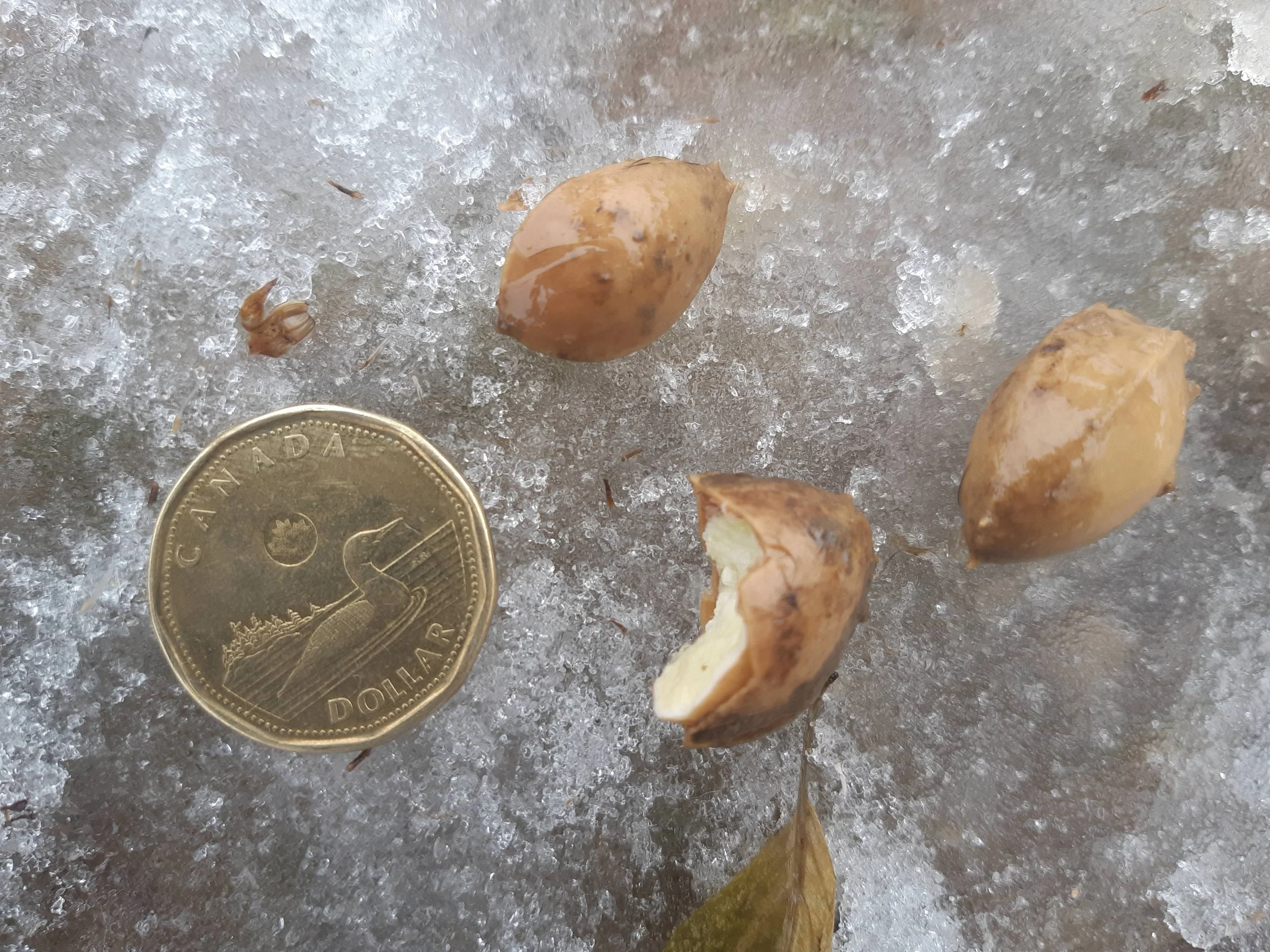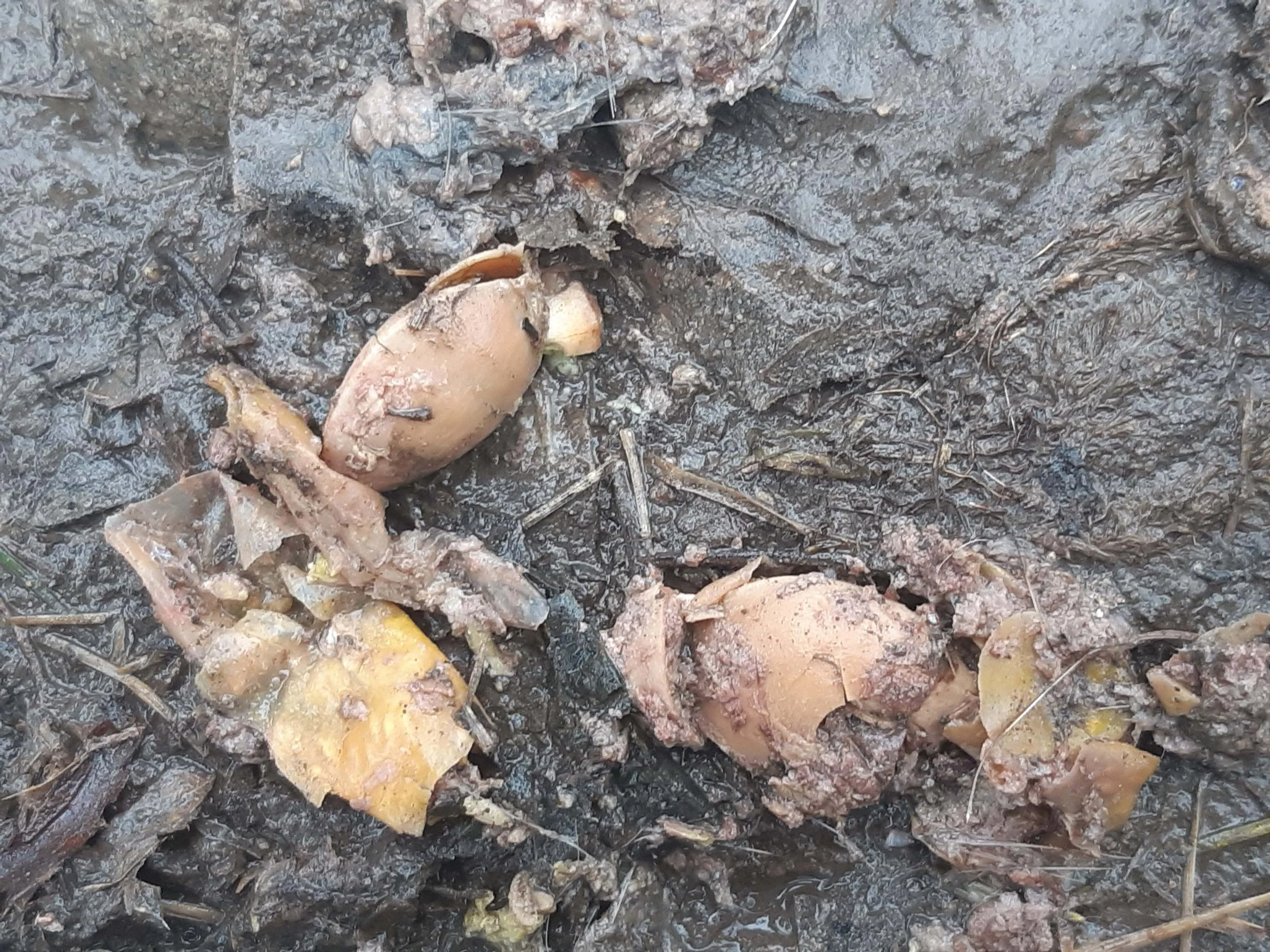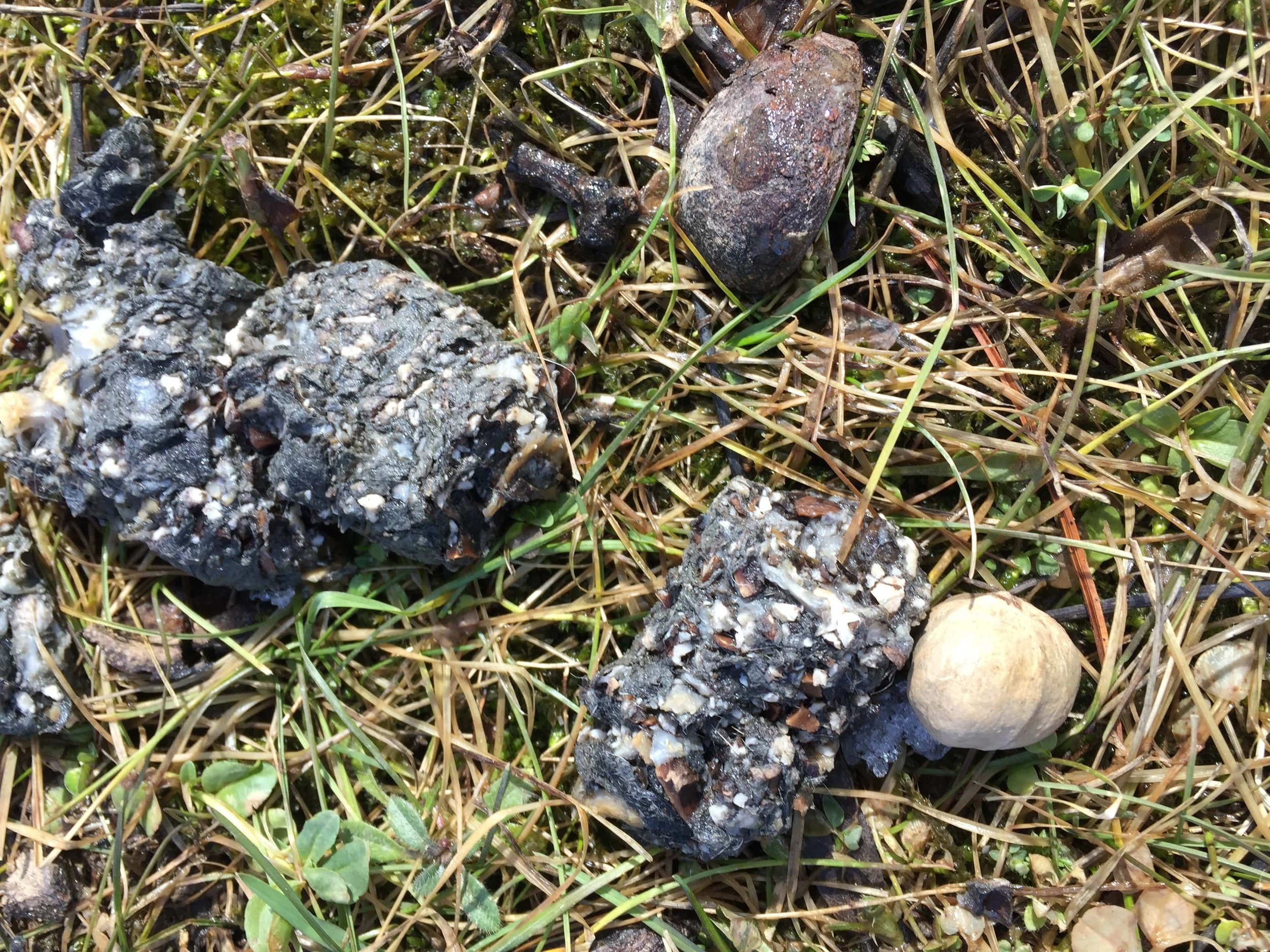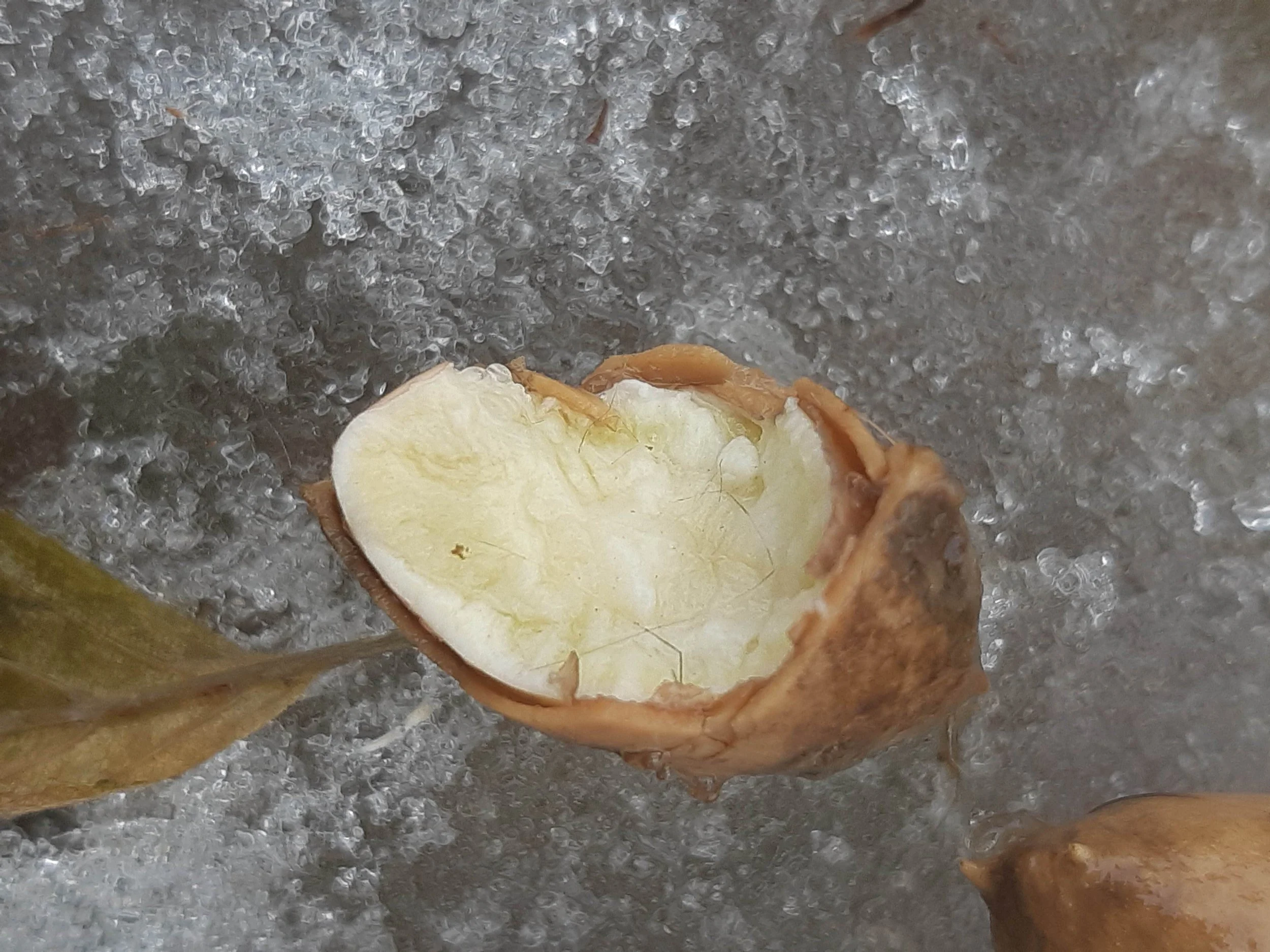An old s****y mystery
A few years ago I was walking with a friend of mine along the trail towards the forest where I work. Along the way I happened to spot some scat in the middle of the trail. It was tapered and long, fairly fat, and had some seeds in it. The scat appeared to have come from a Coyote (Canis latrans) but I was at a loss as for what kind of plant the seeds had come from. The seeds were quite large, smooth, oblong, and reminded me a three sided football. There was soft yellowy kind of flesh found with the seeds partially digested within the scat. I looked up a couple of books I have which have a few photographs of seeds but never found an image of a seed which looked right. In November 2018, I posted the photos online asking if anyone knew what they were, but got no constructive responses. The mystery haunted me.
For a few years the quest continued a quiet way. As I flipped through pages of books, or read things online I would see the same colour, or shape of some seed which reminded me of seeds from the scat. In 2021 I took time to specifically focus on seeds and fruit, all the while wondering who the mystery pit belonged to. Was it a Hickory (Carya spp.) nut of some kind? No, but they look quite similar. Was it a Peach (Prunus persica) pit? No, Peach pits are ridged and rough, while the unknown seed was smooth with three simple ridges. What could it have been?
Julia’s photo of the Coyote scat with a Hickory nut beside.
A couple of weeks ago, my friend Julia was telling me that she had taken a photo of some Coyote scat with Hickory shell and nut pieces inside it. When she did, the quest was called to mind and I asked her if she could send the photo to me, and I told he about the quest. She said sure, and a day later the image arrived. There in the photo were some large dark droppings from the animal with flecks of pale-something-or-other, along with lots of unknown small seeds, potentially from from Hawthorns (Crataegus spp.) along with a big pale seed that was pretty much the ideal form of a Hickory. It wasn’t my mystery seed but I had a feeling it wasn’t going to be anyways as the Hickorys weren’t right in my previous research. Feeling a little dispirited, I sent along the photos I had taken years ago explaining that no, they weren’t like the Hickorys in her photo. In just over a half hour, Julia wrote back with a small simple phrase, betraying the years of exploration and searching my quest had led me on.
“they look like Gingkoes”
I felt like time froze. Was this the answer? Julia has been studying trees for a while now so she would know, but how could there be an answer? I have been looking for one for years! How can she just write so flatly, without great circumstance and presentation..
“they look like Gingkoes”
I looked it up of course, and for sure, she was right. It was the seed from a Ginkgo fruit. All along under my nose, but also, not? Where was a Ginkgo tree near where I had found the scat? I think there were a couple downtown Guelph, but I don’t think the Coyote had gone all that way, from out at the far edge of the outskirts of town, over to the middle of the city to find a fruit that likely wasn’t there? See, Ginkgoes are dioecious, meaning that the pollen producing catkins and pistilate flowers grow on separate trees, and while many cities and municipalities plant Ginkgoes for their interesting form, leaves which turn a golden-yellow in the Autumn, for their resilience from insect pests, diseases and tolerance of pollution, the cities only really plant the pollen cone-bearing trees, not the “fruit”-bearing ones. This is because the “fruits” from the Ginkgoes are said to smell awful. I have read differing accounts of the “offensive odour” but some descriptions include rancid butter, vomit, Dog (Canis lupus familiaris) excrement, and one writer characterizing them as smelling like “some kind of extremely pungent, odiferous cheese”. Yet, despite any municipal misgivings here was the seed from a Gingko “fruit”.
It took a change of perspective to start to get a clear idea of where the seed may have come from. I had to think broadly about the area and consider the valley where the scat was found, the movement of the Coyote, and consider a wider territorial frame.
Wildlife researcher Brent Patterson mentions that Coyote territories can vary in size from 110 km squared in Northern regions of Quebec, and in Newfoundland yet in Prince Edward County in Ontario ranges have been mapped at around 14.5 km squared. In the urban landscape, the territories are only a couple of kilometers large. The differences in territorial sizes is related to food abundance, meaning if there is less food in a specific area where the Coyotes are hanging out, then they will travel further to acquire more food. If there is an abundance of food then they won’t. It seems like cities and suburbs have a lot of food resources, including higher concentrations small rodents, more human food waste, more pet food left out in the bark yard, or potentially even more pets to consume. In peri-urban environments where I found the scat there is a chance for urban incursions for food and then retreats back out into less occupied spaces. But where were the Coyotes getting the seeds?
Sometimes the obvious is only revealed when you take a second look. I couldn’t figure it out right away, but then it struck me. About 1.6 km (1 mile) away there is the University of Guelph Arboretum, a tree zoo as I characterize it for the kids I teach, where there are undoubtedly Ginkgoes growing. When I came to this realization, I looked it up and it turns out that the Arb has at least three Ginkgoes growing there, but I am still uncertain about whether they have any seed producing plants. I would imagine they do, as they would want to propagate them and grow the collection, but I am still uncertain. Despite the uncertainty though, this is my top guess for where the Ginkgo came from as 1.6 km is not a very far distance for a Coyote to meander in one night.
Holding mysteries is a lot of fun. It keeps me aware and on the lookout. When there is a persistent unknown, my curiosity takes on a wide angled vision and I am always looking out of the corners of my researching eyes for any clues and cues which may direct me towards an answer, all the while learning new things and bringing up more questions. This “wonderkeeping” occurs a lot and it often takes quite a bit of time for the answers to come. This particular mystery seed took over 4 years to figure out, and I still need to wait until the Autumn to see if the Gingkoes at the Arboretum put on fruit. I hope in the Autumn I remember to make the time to visit the Arb and see the fruit hanging from the tree, and maybe a some Coyote tracks beneath.




